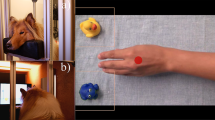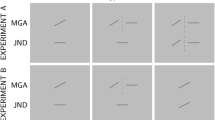Abstract
Because muscle torques counteracting gravity vary systematically during a movement of the arm, it has been suggested that torque differences that occur during a movement provide important information for judging the distance moved away from the body. To test this suggestion, we examined whether external vertical forces applied to the hand (and the torque differences due to these forces) influence proprioception. In a first experiment, the added vertical forces were constant, resulting in a change in torque that was proportional to the gravitational torque, as when holding an object in your hand. This did not affect proprioception. In a second experiment, gradient force fields were used to dramatically change the torque differences. Again, no effect on proprioception was found. Thus, vertical forces caused by hand-held objects do not play an important role in judging the position or movement of the hand.






Similar content being viewed by others
References
Ansems GE, Allen TJ, Proske U (2006) Position sense at the human forearm in the horizontal plane during loading and vibration of elbow muscles. J Physiol 576(2):445–455
Collani GV (1979) An analysis of illusion components with L- and ⊥-figures in active touch. Q J Exp Psychol 31:241–248
Darling WG, Hondzinski JM (1999) Kinesthetic perception of earth- and body- fixed axes. Exp Brain Res 126:417–430
Debats NB, Kingma I, Beek PJ, Smeets JBJ (2010) Muscular torque can explain biases in haptic length perception: a model study on the radial-tangential illusion. Lect Notes Comput Sci 6192:392–397
Deregowski J, Ellis HD (1972) Effect of stimulus orientation upon haptic perception of the horizontal–vertical illusion. J Exp Psychol 95:14–19
Fisk J, Lackner JR, DiZio P (1993) Gravitoinertial force level influences arm movement control. J Neurophysiol 69:504–511
Heller M, Calcaterra J, Burson L, Green S (1997) The tactual horizontal–vertical illusion depends on radial motion of the entire arm. Percept Psychophys 59:1297–1311
Kuling IA, Brenner E, Smeets JBJ (2013) Proprioception is robust under external forces. PLoS One. doi:10.1371/journal.pone.0074236
Kuling IA, Van der Graaff MCW, Brenner E, Smeets JBJ (2014) Proprioceptive biases in different experimental designs. Lect Notes Comput Sci 8618 (in press)
Lackner JR, DiZio P (2000) Human orientation and movement control in weightless and artificial gravity environments. Exp Brain Res 130:2–26
Marchetti F, Lederman S (1983) The haptic radialtangential effect: two tests of Wong’s “moments-of-inertia” hypothesis. Bull Psychon Soc 21:43–46
McFarland J, Soechting JF (2007) Factors influencing the radial-tangential illusion in haptic perception. Exp Brain Res 178:216–227
Perry JC, Rosen J, Burns S (2007) Upper-limb powered exoskeleton design. IEEE ASME Trans Mechatron 12:408–417
Rincon-Gonzalez L, Buneo CA, Tillery SIH (2011) The proprioceptive map of the arm is systematic and stable, but idiosyncratic. PLoS One. doi:10.1371/journal.pone.0025214
Smeets JBJ, Van Den Dobbelsteen JJ, De Grave DDJ, Van Beers RJ, Brenner E (2006) Sensory integration does not lead to sensory calibration. PNAS 103:18781–18786
Soechting JF (1982) Does position sense at the elbow reflect a sense of elbow joint angle or one of limb orientation? Brain Res 248:392–395
Sousa R, Brenner E, Smeets JBJ (2010) A new binocular cue for absolute distance: disparity relative to the most distant structure. Vis Res 50:1786–1792
Winter DA (1990) Biomechanics and motor control of human movement, 2nd edn. Wiley, Chichester
Wong TS (1977) Dynamic properties of radial and tangential movements as determinants of the haptic horizontal–vertical illusion with an ‘L’ figure. J Exp Psychol Hum Percept Perform 3:151–164
Worringham CJ, Stelmach GE (1985) The contribution of gravitational torques to limb position sense. Exp Brain Res 61:38–42
Acknowledgments
This research is supported by the Dutch Technology Foundation STW, which is part of the Netherlands Organization for Scientific Research (NWO) and partly funded by the Ministry of Economic Affairs, Agriculture and Innovation. STW grant 12160.
Author information
Authors and Affiliations
Corresponding author
Rights and permissions
About this article
Cite this article
Kuling, I.A., Brenner, E. & Smeets, J.B.J. Torques do not influence proprioceptive localization of the hand. Exp Brain Res 233, 61–68 (2015). https://doi.org/10.1007/s00221-014-4086-7
Received:
Accepted:
Published:
Issue Date:
DOI: https://doi.org/10.1007/s00221-014-4086-7




